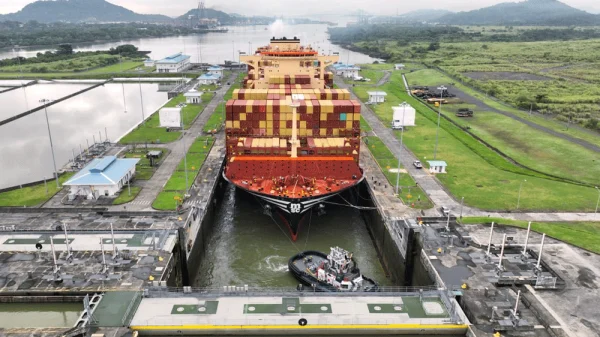Plastics: an ocean justice crisis

Much like the case of climate change, those who bear the worst impacts of plastics gain the fewest benefits from their production or use, writes Rachel Bustamante
AS THE fourth negotiating session on the United Nations plastics treaty comes to a close, pressing questions loom: Will world leaders finalise a robust agreement by the end of this year that effectively halts plastic pollution at its source? Despite the fortitude of countries within the High Ambition Coalition like Rwanda and Peru, negotiations on the agenda of intersessional work leading up to the final session in November in Busan, Korea, left the crucial aspect of reducing plastic production off the table.
Divergence surrounding the root causes of plastic pollution was ignited by the overwhelming presence of the fossil fuel and chemical industry. And their impact was not hard to miss, with pro-plastic campaigners outside the Shaw Center where negotiations were held and nearly 200 lobbyists registering for the talks, even joining country delegations, according to a Center for International Environmental Law analysis. Their influence is far-reaching. Notably, the US, being the world’s largest contributor to plastic waste, has not taken a stance on production.
I conveyed this message on Earth Day during a youth coalition meeting with US Senators Sheldon Whitehouse, Kirsten Gillibrand, Jeff Merkley, Welch, and representative Jared Huffman. I advocated for the negotiators to prioritise increasing protections for human rights and ocean health by centring justice.
Despite widespread discussions on the environmental and human health risks of plastics, there is still a noticeable gap in recognising the interconnected injustices they perpetuate — though the Global Youth Coalition on Plastic Pollution and Indigenous Peoples’ Caucus were adamant about these connections in their plenary statements. While plastics impact everyone — microplastics are in our air, food, water, soil, and bodies, even human placentas — disproportionate negative impacts occur across race, occupation, ethnicity, class, gender, and age.
Outside the plastics context, voices like Dr Ayana Elizabeth Johnson have brought justice to the forefront of ocean conservation, while Leah Thomas is the leading activist for Intersectional Environmentalism. As a Gen Z advocate deeply immersed in ocean advocacy, in my view, this is what the plastics conversation still needs: utilising an intersectional approach to shed light on how the full plastic lifecycle — from creation to waste — represents an ocean justice crisis.
Ocean health
UPON returning from the fourth session of the Intergovernmental Negotiating Committee to develop an international legally binding instrument on plastic pollution, including in the marine environment (INC-4), I went to the beach for rest and was, paradoxically, as usual, immediately picking up plastic waste. And still, I acknowledge my privileged position — that ocean currents are naturally not bringing as much pollution to the North Carolina coast as they are to vulnerable island countries. Each year 11 million metric tons of plastic enter the seas, devastating wildlife, contaminating seafood, and polluting beaches. But, those most severely affected are often the least culpable: island countries, indigenous peoples, and the Global South. This pollution is compounded by the plastic loads high GDP countries export to the Global South, a trend called ‘waste colonialism.’
Undeniably, the ocean is profoundly impacted by plastic pollution, evident in the vast gyres twice the size of Texas and the grim prediction that by 2050, 99 per cent of seabirds will have ingested plastics.
Not only does this pollution entangle marine life and release toxic chemicals, scientists are beginning to worry it is threatening the ability of the ocean to sequester carbon. Zooplankton are microscopic animals that are now replacing their plant diet with microplastics, and this trend on a large scale is hypothesized to hinder the release of carbon to the deep sea.
Human rights
DESPITE widespread support by countries for including human rights in the plastics treaty, there are no obligations to protect the rights of indigenous peoples, of informal waste pickers whose livelihoods depend on plastic collection, or of anyone. In a report, Earth Law Center reviewed nearly 400 statements across 175 member states to the INC and mapped support by country. Unsurprisingly, regions across the Global South experiencing the brunt of plastic pollution and human rights injustices demonstrated the highest support.
Many people don’t know not to microwave plastic. Just as many are not aware that there are 16,000 chemicals associated with plastics and over one in four are hazardous to people. Or that microplastics are found in human blood and we don’t know the consequences yet. However, this awareness is largely not the fault of the public. The plastic industry intentionally keeps us in the dark, having us thinking that plastic is non-toxic and safe to use, and even fooling us that recycling is the end-all solution. Banning and phasing out concerning chemicals and single-use plastics while increasing plastic literacy is key to protecting human rights, ensuring industries are transparent, and empowering everyone to make informed decisions.
Justice
ACCORDING to UN Environment Program, the plastic lifecycle is a barrier to every Sustainable Development Goal. Without immediate action to reduce plastic production, we risk our chance to keep the 1.5°C target within reach. Much like the case of climate change, those who bear the worst impacts of plastics gain the fewest benefits from their production or use. Black, indigenous, and people of colour communities are disproportionately harmed by toxic chemicals and emissions from unfair proximity to petrochemical and incineration facilities. Women and people who menstruate are exposed to microplastics within period products. The bottom line is plastics exacerbate inequities and harm those most vulnerable among us.
Right now, the word ‘justice’ is not in the plastics treaty text at all. As the outcomes of negotiations unfold, I hope that plastics will be reframed as what they truly are: an ocean justice crisis. The treaty, slated for finalisation by the end of 2024, represents a pivotal opportunity to safeguard human rights and address injustice. There are undeniable implications for people, the ocean, and truly, the planet at stake.
CommonDreams.org, May 5. Rachel Bustamante is the ocean programme director at Earth Law Center. With a background in ocean and plastics policy and as a passionate Gen-Z advocate, she is dedicated to identifying intersectional and ethical solutions to advance justice and care for this blue planet. She recently developed the youth-led report: ‘Advancing Ocean Justice in the Global Plastics Treaty.’























Leave a Reply